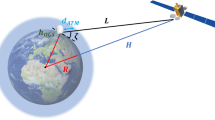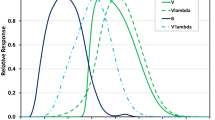Abstract
This paper presents a comprehensive review of channel models for deep space communications. Based on the characteristics of environment, deep space channels can be divided into three kinds, i.e., near Earth link, interstellar link and near planet link. The modeling for different kinds of channels are summarized respectively, and some simulation results are provided in this paper. In addition, according to the development trend of deep space communications, optical wave will become an important carrier in the future. Therefore, deep space optical communication is also briefly introduced. Finally, challenges of deep space channel modeling are pointed out and future research direction is also discussed.
Similar content being viewed by others
References
Liu J X. Forward to the deep space: developing trend of TTC&DT technology. Telecommun Eng, 2006, 2: 1–8
Zhang Y F, Du J C, Xiao S. Analysis and simulations on characteristics of deep space channel model VPAWGN. Space Electron Technol, 2010, 7: 22–25
Bokulic R S, Moore W V. Near Earth asteroid rendezvous spacecraft solar conjunction experiment. J Spacecr Rockets, 1999, 36: 87–91
Woo R. Radial dependence of solar wind properties deduced from HELIOS 1/2 and pioneer 10/11 radio scattering observation. Astrophys J, 1978, 219: 727–739
Woo R, Yang F C, Ishimaru A. Structure of density fluctuations near the Sun deduced from Pioneer-6 spectral broadening measurements. Astrophys J, 1976, 210: 593–602
Morabito D D, Shambayati S, Finley S, et al. The Cassini May 2000 solar conjunction. IEEE Trans Antenn Propag, 2003, 51: 201–219
Bokulic R S, Flaherty M K E, Jensen J R, et al. The NEAR spacecraft RF telecommunications system. Johns Hopkins APL Tech Digest, 1998, 19: 213–219
Feria Y, Belongie M, Mcpheeters T, et al. Solar Scintillation Effects on Telecommunication Links at Ka-band and X-band. TDA Progress Report 42-129, 1997
Morabito D D. Solar Corona Amplitude Scintillation Modeling and Comparison to Measurements at X-band and Ka-band. IPN Progress Report 42-153, 2003
Liu Q, Mei J J, Yao Y L, et al. Analysis of deep space channel model characteristics and its simulation. J Air Force Radar Acad, 2012, 3: 181–184
Hu X B, Xu H T, Zhou X W. Research of transmission loss analysis in deep space communication. In: Proceedings of International Conference on Cyberspace Technology, Beijing, 2013. 380–383
Xu H T, Zhou X W. Ka-band satellite channel model in deep space relaying network. Wirel Pers Commun, 2014, 77: 881–888
Zhou H, Zheng H X, Xu D G. Space Communication Technology. Beijing: National Defense Industry Press, 2010. 271–280
Lu W Q, Pan C S. An analysis of the factors that may affect the electromagnetic wave propagation in the space communications. Fire Control Command Control, 2004, 21–24
Zhang G X, Zhang H. Satellite Mobile Communication System. Beijing: Posts and Telecom Press, 2001
Guo Y, Zhao W J. Research and implementation of the satellite channel two-state markov model under the cloudy and foggy weather. In: Proceedings of the 5th International Conference on Information Engineering for Mechanics and Materials. Berlin: Springer, 2015
Sun K, Hou X, Zhao Q. Channel modelling and performance analysis of the near space based on the DS signal system. In: Proceedings of MATEC Web of Conferences, Les Ulis, 2016
Perez-Fontan F, Castro M A V, Enjamio C, et al. Comparison of generative statistical models for the LMS channel. In: Proceedings of the 55th Vehicular Technology Conference, Birmingham, 2002. 871–875
Shen D Y, Cui Y N, Zhang A F, et al. A simple simulation method for nakagami fading channel. In: Proceedings of International Conference on Microwave and Millimeter Wave Technology (ICMMT), Chengdu, 2010. 160–163
Biscarini M, Marzano F S, Montopoli M, et al. Weather effects mitigation at Ka-band by using radiometeorological model forecast in deep space downlinks. In: Proceedings of the 9th European Conference on Antennas and Propagation, Lisbon, 2015
Morabito D D. Solar coronar induced fluctuations on spacecraft signal amplitude observed during solar superior conjunctions of the Cassini spacecraft. Radio Science, 2016, 42: 1–16
Xue Y H, Chai Y, Liu N B, et al. Sky-wave OTHR ionospheric channel modeling. Chinese J Radio Sci, 2013, 28: 862–868
Morabito D D. Spectral broadening and phase scintillation measurements using interplanetary spacecraft radio links during the peak of solar cycle 23. Radio Sci, 2009, 44: 1–23
Wu T, Yan Y, Li Y C, et al. Deep space channel modeling and the analysis of wave propagation environment characteristics under solar scintillation. Chinese J Radio Sci, 2015, 30: 417–422
Morabito D D. Solar Corona Amplitude Scintillation Modelingand Comparison to Measurements at X-band and Kaband. PN Progress Report 42-153, 2003
Morabito D D, Shambayati S, Butman S, et al. The 1998 Mars Global Surveyor Solar Corona Experiment. TMO Progress Report 42-142, 2000
Rao Q L. The link analyzation and design based on CCSDS for Mars probe TTC&C system. Dissertation for Master Degree. Shanghai: Shanghai Jiaotong University, 2012
Liu Z H. Ka band deep space communication channel modeling based on the exploration of Mars. Dissertation for Master Degree. Suzhou: Suzhou University, 2012
Morabito D D, Schratz B, Bruvold K, et al. The Mars Science Laboratory EDL Communications Brownout and Blackout at UHF. IPN Progress Report 42-197, 2014
Wood G E, Asmar S W, Rebold T A, et al. Mars Pathfinder Entry, Descent, and Landing Communications. TDA Progress Report 42-131, 1997
Esatorius E, Estabrook P, Wilson J, et al. Direct-to-Earth Communications and Signal Processing for Mars Exploration Rover Entry, Descent and Landing. IPN Progress Report 42-153, 2003
He G L, Zhan Y F, Zhang J Z, et al. Characterization of the dynamic effects of the reentry plasma sheath on electromagnetic wave propagation. IEEE Trans Plasma Sci, 2016, 44: 232–238
Zhang J Z, He G L, Bai P, et al. Characterization and performance evaluation of turbulent plasma sheath channel. China Commun, 2016, 13: 88–99
Zhang J Z, He G L, Bai P, et al. Dynamic channel modeling for communication through turbulent plasma sheath. In: Proceedings of International Conference on Wireless Communications & Signal Processing, Nanjing, 2015
He G L, Zhan Y F, Ge N, et al. Channel characterization and finite-state Markov channel modeling for time-varying plasma sheath surrounding hypersonic vehicles. Prog Electrom Res, 2014, 145: 299–308
Ma H J, Zhu X L. The latest progress of free space laser communications. Laser Optoelectron Prog, 2005, 42: 7–11
Wilson K E. Overview of the ground-to-orbit laser communication demonstration. Proc SPIE, 1997, 2990: 23–30
Chen C C. Overview of the optical communications demonstrator. Proc SPIE, 1994, 2123: 85–94
Ma J, Tan L Y. The progress and trend of researches of intersatellite optical communications. Chinese J Space Sci, 2000, 20: 128–136
Kim I I. Preliminary result of the STRV-2 satellite-to-ground lasercom experiment. Proc SPIE, 2000, 3932: 21–34
Ke S Y. The research of channel model in space laser communication. Wuhan: Huazhong University of Science & Technology, 2007
Boroson D M, Scozzafava J J, Murphy D V, et al. The lunar laser communications demonstration. In: Proceedings of the 3rd IEEE International Conference on Space Mission Challenges for Information Technology (SMC-IT), Pasadena, 2009. 23–28
Zhu X, Kahn J. Performance bound for coded free-space optical communication through turbulence channel. IEEE Trans Commun, 2003, 51: 1233–1239
Rao R Z, Wang S P. Experimental study of spot dancing of laser beam in a turbulent atmosphere. Chinese J Lasers, 2000, 27: 1011–1015
Lu Y, Lin Y S. The simple method to calculate the atmosphere transmittance of infrared radiation. Infrared Technol, 2003, 25: 45–49
Fan W, Wang Y, Rao R Z. Wavelength band selection method for taget detection based on character of atmosphere radiation. Infrared Laser Eng, 2005, 34: 177–182
Climate Literacy Labs of Georgia State University. Lab 5: global surface temperature. 2014. http://sites.gsu.edu/ geog1112/global-surface-temperature/
Wu C J, Yan C X. Overview of space laser communication. Chinese J Opt, 2013, 6: 670–678
Acknowledgments
This work was supported by National Natural Science Foundation of China (Grant Nos. 61671263, 61271265), and Tsinghua University Independent Scientific Research Project (Grant No. 20161080057).
Author information
Authors and Affiliations
Corresponding author
Rights and permissions
About this article
Cite this article
Pan, X., Zhan, Y., Wan, P. et al. Review of channel models for deep space communications. Sci. China Inf. Sci. 61, 040304 (2018). https://doi.org/10.1007/s11432-017-9345-8
Received:
Revised:
Accepted:
Published:
DOI: https://doi.org/10.1007/s11432-017-9345-8




